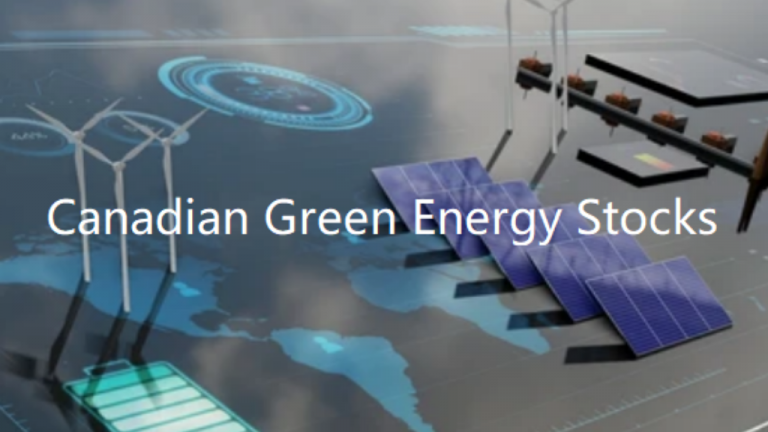In Canada, increasing numbers of individuals are growing interested in green energy. To help the world, many people attempt to use green energy and resources whenever possible. However, people also use green energy to power their homes and businesses. Green energy is gradually becoming one of the most prominent and lucrative investment ideas worldwide.
Table of Contents
What Is A Green Energy Stock?
Green energy companies generate electricity via renewable or naturally replenishing resources.
The most prevalent and ancient source of green energy is water. Thousands of years ago, water wheels were used to harness the power of water. Over 67% of Canada’s total green energy production is derived from water, making it the most popular source of green energy.
Other sources include:
- Solar (electricity through a solar panel)
- Wind (same principle as water)
- Ethanol
- Biodiesel
- Tidal
Solar and wind energy are inexhaustible and produce more than enough electricity to power the entire earth (even in its currently over-populated state). The ethically pragmatic rationale for selecting renewable energy over fossil fuels is that renewable energy does not destroy the environment as fossil fuels do.
Some claim that the transition from fossil fuels to renewable energy will kill the energy industry as it stands, harming the lives and livelihoods of millions of people, particularly in an energy-intensive nation like Canada. However, this is an inevitable next step, and the sooner the world acknowledges this, the better for the planet and for ourselves.
How Should You Select Green Energy Stocks?
Canada’s green energy industry is enormous, and selecting the proper company takes careful consideration of a number of variables.
First, it is essential to determine the type of clean energy generation they are engaged in. Diversification is essential, and the top green energy stocks in Canada are typically companies that have diversified into all forms of clean energy generation.
Being involved in all sub-sectors, from solar to wind to hydropower, will help mitigate the risk of a decline in any one sub-sector.
Due to the fact that many of Canada’s leading green energy companies have a global presence, it is also necessary to monitor foreign events.
Companies that have invested in nations with rules favorable to green energy are likely to experience bigger returns.
For instance, the United States just passed a $1.2 trillion infrastructure bill that allocates substantial financing to clean energy projects.
Investors interested in capitalizing on this opportunity should seek Canadian sustainable energy companies with active activities in the United States.
How Should You Select Green Energy Stocks?
Canada’s green energy industry is enormous, and selecting the proper company takes careful consideration of a number of variables.
First, it is essential to determine the type of clean energy generation they are engaged in. Diversification is essential, and the top green energy stocks in Canada are typically companies that have diversified into all forms of clean energy generation.
Being involved in all sub-sectors, from solar to wind to hydropower, will help mitigate the risk of a decline in any one sub-sector.
Due to the fact that many of Canada’s leading green energy companies have a global presence, it is also necessary to monitor foreign events.
Companies that have invested in nations with rules favorable to green energy are likely to experience bigger returns.
For instance, the United States just passed a $1.2 trillion infrastructure bill that allocates substantial financing to clean energy projects.
Investors interested in capitalizing on this opportunity should seek Canadian sustainable energy companies with active activities in the United States.
What you must know before investing in green energy stocks
The purpose of this list of the finest green energy stocks in Canada is to assist you in conducting your own research to identify the best green energy stocks to purchase right now. It is not investment guidance. No single stock or list of stocks will be suitable for all investors, as we all have different objectives and requirements.
Whether you are more concerned with short-term capital gains or long-term dividend growth, it is essential to know whether a stock is performing well, earning a profit, paying dividends, or declining. Always keep in mind that past success is not indicative of future results, and investments can fluctuate in value.
Why Invest In Green Energy Stocks?
Investing in clean energy stocks (also known as green energy stocks by some experts) is based on the investment thesis that, as corporations face increasing political pressure from a global population that is increasingly traumatized by natural disasters, clean energy companies will be the natural beneficiaries.
I’m unsure of the degree to which the world is prepared to embrace clean energy at the expense of overall profitability, but I’m more certain that as we shift to need more and more electricity, all sources of energy will be sought after. From this long-term perspective, clean energy stocks look to be a less risky investment than non-Saudi oil companies.
As with all aspects of investing, the question concerns both value and long-term prospects. Most individuals agree that when renewable energy companies expand, they will earn more money than they do presently.
Best Canadian Green Energy Stocks
Algonquin Power Stock
Algonquin is undoubtedly one of the top green energy stocks on the TSX now. It is a dividend aristocrat (nine years of uninterrupted payments) with a respectable yield, and its payouts have grown at a rapid rate (61% between 2017 and 2021).
Liberty power and Liberty utilities are the two principal entities under which the corporation operates. Liberty power has invested in 35 renewable energy generating plants, including wind, solar, and hydropower. In contrast, Liberty utilities are responsible for the distribution of power, water, gas, and wastewater treatment.
The corporation has assets totaling $11 billion, more than 267,000 electrical connections, and more than 369,000 gas connections. This company’s phenomenal growth is partially attributable to its end-to-end production and distribution.
Canadian Solar Inc (NASDAQ: CSIQ)
One of the key reasons we have never included a Canadian solar company on this list of green energy stocks is that the greatest solar companies trade on the NASDAQ in the United States.
However, due to increasing demand, we believe it is time to begin discussing Canadian Solar Inc. (NASDAQ: CSIQ).
Solar stocks have been on the rise recently, but from its lows in March 2020, Canadian Solar has increased by nearly 81%.
Green energy companies have had a severe correction, which has caused the stock to decline considerably from its all-time highs. Nonetheless, a bullish mindset persists.
We believe investors and analysts are beginning to recognize the potential of the once-small cap Canadian (but U.S.-traded) company.
Canadian Solar has a relatively cheap manufacturing cost and a substantial number of future projects planned.
Initially, solar electricity was met with considerable opposition, and it had extraordinarily high production costs and was not viewed as a permanent replacement for dirtier kinds of energy.
In reality, though, we wouldn’t even need to collect one-hundredth of one percent of the energy striking the globe each year to eliminate all other forms of energy production. And as production prices decrease, it becomes a more viable technique for producing clean energy.
Canadian Solar has proven to be a very disappointing stock for value investors.
However, Canadian Solar is still favorably valued considering the potential of solar energy despite an 81% increase in value.
Trading at only 0.38 times estimated sales for 2021 and 14.23 times expected earnings for 2021, values are not excessive. The market is not really prepared to pay a high earnings multiple because the company’s growth has been very uneven. However, the majority of its discrepancies have been caused by the aforementioned points.
It is anticipated that growth will resume in 2022 and 2023, with 2023 revenues of $7 billion USD representing a 100% rise from 2020 revenues of $3.47 billion USD. There is promise in the business, and the company is likely worth a look at its current valuation.
Notably, this is the only green energy stock on this list that does not currently pay a dividend, and we would also consider it as the stock with the most risk.
Northland Power (TSX: NPI)
Northland Power (TSX: NPI) is a green energy firm that has been in operation for many years. The company was founded in 1987 and currently operates about 2.8 GW of power, with a future potential capacity exceeding 5 GW.
Over the past three years, Northland has had a compound annual growth rate (CAGR) in excess of 30% in terms of revenue. Since 2015, the company has also managed to more than double its sales.
The majority of the company’s environmentally green operations are based in eastern Canada.
In fact, the company’s westernmost plants are in Saskatchewan: the Spy Hill facility with 86 MW of capacity and the North Battleford facility with 260 MW of capacity. Both of these plants generate electricity by combusting natural gas, and their separate contracts run until 2036 and 2033.
Two of the company’s total 27 assets have already been discussed. With 19 locations in Ontario, Northland has a significant proportion of its assets in the province. The Netherlands and Germany both have one wind farm, with the Netherlands’ wind farm located offshore.
In September of 2019, the green firm completed its acquisition of EBSA, a regulated utility provider in Colombia, for around $1.05 billion. EBSA serves nearly half a million consumers, and its revenue is closely controlled, making it highly reliable. It also generates substantial revenue for Northland Power outside of North America.
In terms of performance, Northland Power has not disappointed in the last year and a half. Similar to other Canadian green energy stocks, it was severely affected by the slump at the beginning of 2021. However, it held up better than others and did not experience the volatility experienced by many small/micro company green companies.
Currently, the corporation has a yield in the mid 2% area and an earnings payout ratio of 104%. This payout ratio appears high, but at 16.09%, the dividend is adequately supported by cash flow.
Northland Power’s lack of dividend growth is one of the key factors for its low ranking on this list. Especially considering the company’s expansive growth potential.
But don’t be fooled; this is still a very strong stock in the green energy sector, despite the recent downturn owing to seasonal and temporary troubles with its wind farms.
TransAlta Renewables (RNW)
TransAlta Renewables is one of Canada’s major wind power generators and a green energy corporation, and it is a vehicle sponsored by TransAlta Corporation. TransAlta Renewables has amassed extensive experience in owning, running, and maintaining a significant fleet of electricity generation assets for over a century.
TransAlta Renewables owns and manages 21 wind farms, 13 hydropower facilities, seven natural gas plants, one solar facility, and one natural gas pipeline in the United States, Canada, and Australia. Strong counterparties and well-contracted green and natural gas power production assets ensure consistent cash flows for the organization.
TransAlta Renewables owns green energy facilities in various regions and utilizes a variety of technologies. The company owns directly or indirectly about 2,400 MW of net generating capacity and is well placed to serve to expand industrial zones.
Brookfield Renewable Partners Stock
Brookfield is a powerhouse of green energy assets. It oversees approximately 5,318 power generation plants with a total capacity of 19,400 MW. The assets are widely dispersed across four continents and are valued at approximately $52 billion.
The portfolio is predominately (regionally) North American, and hydro is the principal green energy source, comprising around 74% of the total mix. This diversification is one incentive to select Brookfield since it affords significant stock safety.
While the yield may not be particularly enticing, the growth potential is worth examining. The balance sheet is robust, and the company’s revenue growth has been consistent.
This stock’s lack of dividend growth or sustainability is a cause to view it with a healthy amount of suspicion. It is just as likely to reduce your dividends when revenues decline as it is to enhance them when revenues rise.
Enbridge
Enbridge continues to invest extensively in fossil fuels, but it has also been a leader in the Canadian energy sector’s transition to sustainable energy.
The corporation has placed a large emphasis on solar and winds energy and currently operates 23 wind farms and 17 solar energy plants. Over the previous two decades, the corporation has invested over $8 billion in clean energy projects.
Enbridge forecasts that, between its current assets and those in construction, it will soon be able to power close to one million homes with green energy.
Boralex Inc. (TSE: BLX)
Like Innergex, Boralex is an operator of green energy plants. The corporation operates in the hydroelectric, solar, and wind energy sectors, with a modest presence in thermal power. It has facilities in Canada, the United States, the United Kingdom, and France. At the conclusion of the year 2020, the company’s installed capacity was 2,455 MW. Boralex’s share price is C$38.6, and its P/E ratio is 83.60. Its dividend yield is 1.17 percent.
Boralex and Innergex share many similarities, but one key distinction is that Innergex is subject to fluctuating power prices and demand, whereas Boralex enters 10-year fixed-price contracts for the energy supplied by their plants. This provides the business with a consistent cash flow and eliminates downside risk.
After a period of unprofitability, the corporation was able to return to profitability in FY20, making it a noteworthy year. Increased demand due to work-from-home and other lockdown measures and a decline in interest rates, which enabled the company to refinance on more advantageous conditions, were mostly responsible for the return to profitability.
In FY20, Boralex reported $619 million in revenue (up 9.7% YoY), $434 million in EBITDA, and a net profit.
Innergex Renewable Energy (TSX: INE.TO)
Innergex Renewable Energy is one of the most popular renewable energy stocks listed on the TSX (TSX: INE.TO). They are a company that firmly believes in green energy and sees it as a means to promote healthy communities and shared prosperity.
Innergex has a stake in more than eighty active facilities, with many more in the planning stages. They have a varied portfolio that includes hydro, wind, and solar farms and a sustainable business model that prioritizes the prosperity of both people and the earth. This company model provides value to investors through continual expansion based on a long-term perspective.
The Bottom Line
Before selecting the finest Canadian green energy stocks for your portfolio, ensure that they align with your investment objectives and risk tolerance. Typically, utility stocks are very secure, but a number of market situations might still cause their value to decline. Try to purchase these stocks during a decline so you can secure a lower price and a higher yield.




